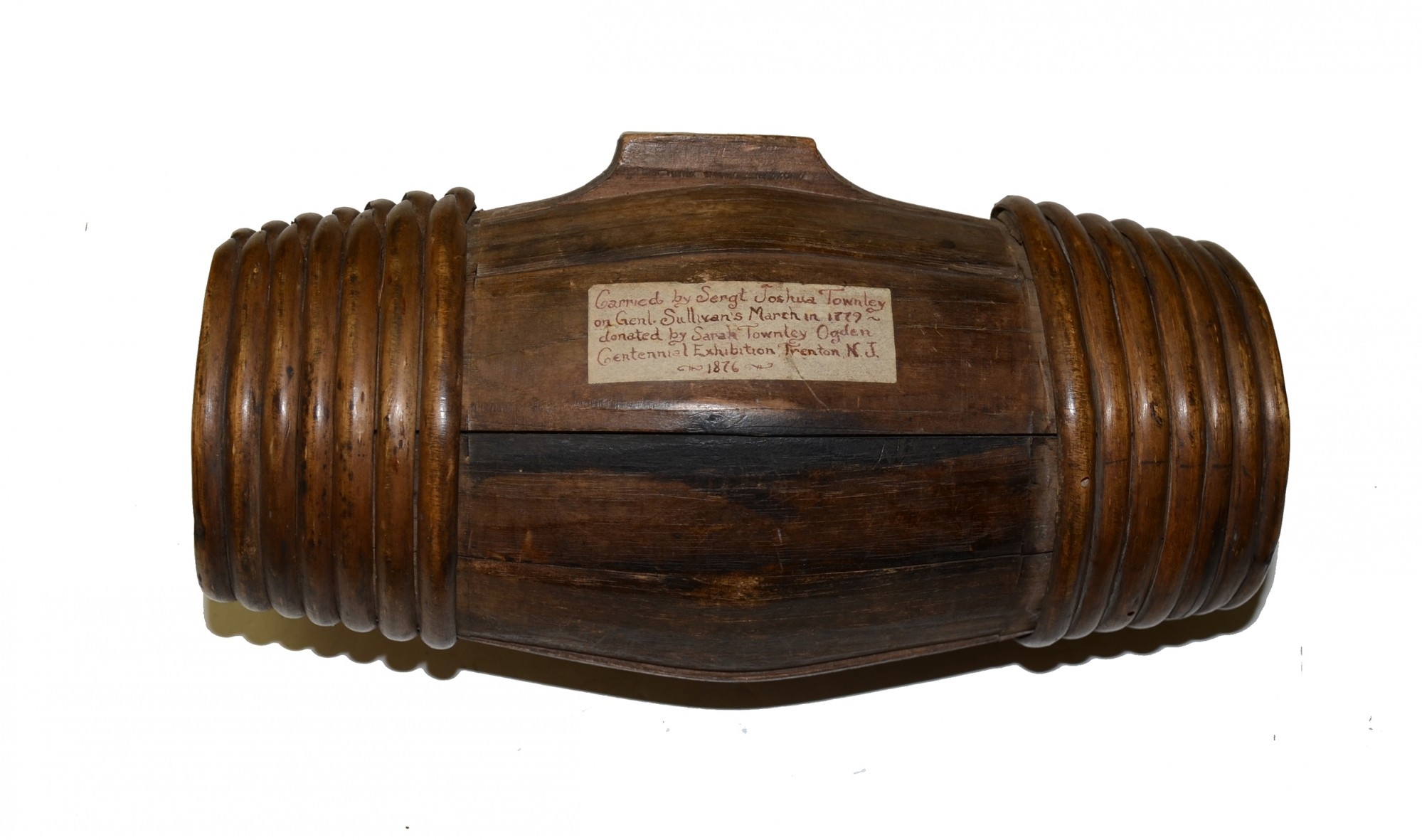site search
online catalog
REV WAR WOODEN RUM KEG

$500.00 SOLD
Quantity Available: None
Item Code: 482-415
Wooden keg dates to 1779. Measures approx. 8.50 inches tall x 3 inches across at the ends. The barrel is made up of eleven slats of wood wrapped in seven layers of willow at each end.
One slat has a hole approx. ¼ inch in circumference. The side of keg has an old handwritten paper label that reads “CARRIED BY SERGT. JOSHUA TOWNLEY ON GENL. SULLIVAN’S MARCH IN 1779- DONATED BY SARAH TOWNLEY OGDEN. CENTENNIAL EXHIBITION TRENTON, N.J. 1876”.
Keg has a wonderful patina and an overall nice look to it. It is in very good condition. Willow bands are slightly loose but intact.
A Sgt. Joshua Townley is found listed on the rolls of the 1st New Jersey Regiment from 1775 to 1780, including the months of 1779 when Sullivan’s March took place, and in which the 1st New Jersey took part. Townley was from Elizabethtown, NJ, where he died on May 13, 1840 at the age of 82.
At the onset of the American Revolution both Great Britain and the Continental Congress hoped the American Indian nations would remain neutral, but that quickly became unrealistic. A few of the eastern tribes did support the Continental Army, but far more Indians decided to fight alongside the British, who had traditionally supplied them with trade goods and prevented the frontier settlers from encroaching on their lands. The British soon realized that their Indian allies were at times unreliable and difficult to control during European-style military engagements. After the defeat and surrender of Burgoyne’s army at Saratoga in 1777, British strategy in the region changed and focused on encouraging allied Indian war bands, led by Loyalist rangers, to launch a series of destructive raids on frontier settlements in western Pennsylvania and New York.
At first George Washington had too few soldiers to fight the British in the east and to protect the western frontier. He expected these exposed areas to use local militiamen to defend themselves, but as these attacks, continued throughout 1778, they not only began to deprive Washington’s army of provisions and manpower but also, by spreading terror, caused the abandonment of many settlements. The situation reached a crisis in November when two companies of Loyalist rangers and more than 300 Iroquois warriors attacked Cherry Valley, New York. While the fort was surrounded, Indians began to massacre civilians in the village, killing and scalping 16 soldiers and 32 civilians, mostly women and children, and taking 80 captive, half of whom were never returned. The town was plundered and destroyed. The Cherry Valley Massacre convinced the American colonists that they needed to take action.
The 1779 Sullivan Expedition was ordered and organized by George Washington and his staff was conducted chiefly in the lands of the Iroquois Confederacy "taking the war home to the enemy to break their morale", and the expedition was largely successful in that goal as they destroyed more than 40 Iroquois villages and stores of winter crops, breaking the power of the six nations in New York all the way to the Great Lakes, as the terrified Indian families relocated to Canada seeking protection of the British. Today this area is the heartland of New York State, and with the military power of the Iroquois vanquished, the events also opened up the vast Ohio Country, the Great Lakes regions, Western Pennsylvania, West Virginia, and Kentucky to post-war settlements.
This keg is a relic from this pivotal point in early American history. [sm/ld]
~~~~~~~~~~~~~~~~~~~~~~~~~~~~~~~~~~~
THIS ITEM, AS WITH ALL OTHER ITEMS AVAILABLE ON OUR WEB SITE,
MAY BE PURCHASED THROUGH OUR LAYAWAY PROGRAM.
FOR OUR POLICIES AND TERMS,
CLICK ON ‘CONTACT US’ AT THE TOP OF ANY PAGE ON THE SITE,
THEN ON ‘LAYAWAY POLICY’.
THANK YOU!
Inquire About REV WAR WOODEN RUM KEG
For inquiries, please email us at [email protected]
Most Popular
Historical Firearms Stolen From The National Civil War Museum In Harrisburg, Pa »
Theft From Gravesite Of Gen. John Reynolds »
Cavalry Carbine Sling Swivel »
Fine Condition Brass Infantry Bugle Insignia »
featured item
FANTASTIC UNIFORM GROUPING OF G.E. ANDREWS: OFFICER’S FROCK COAT, OFFICER’S SHORT JACKET, OFFICER’S TROUSERS, AND HIS TAILOR-MADE FIRST SERGEANT FROCK COAT WITH VETERAN SERVICE STRIPES!
We don’t often use exclamation points in a description, but this identified uniform grouping, formerly in the collections of the Texas Civil War Museum, has not just historical interest, but outstanding eye-appeal. The First Sergeant’s frock coat… (1179-147). Learn More »








